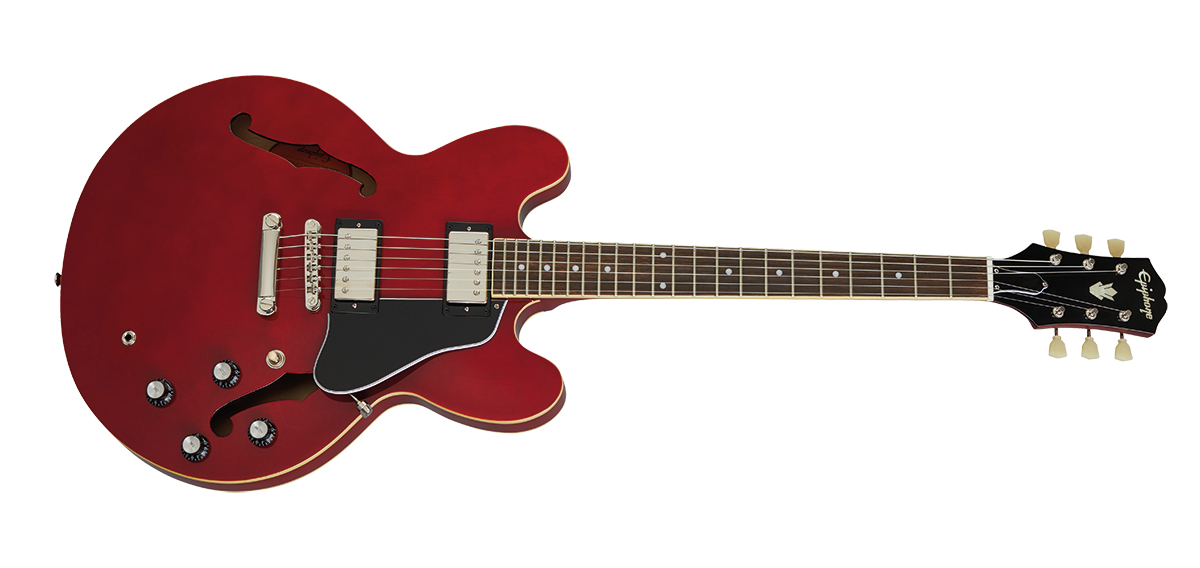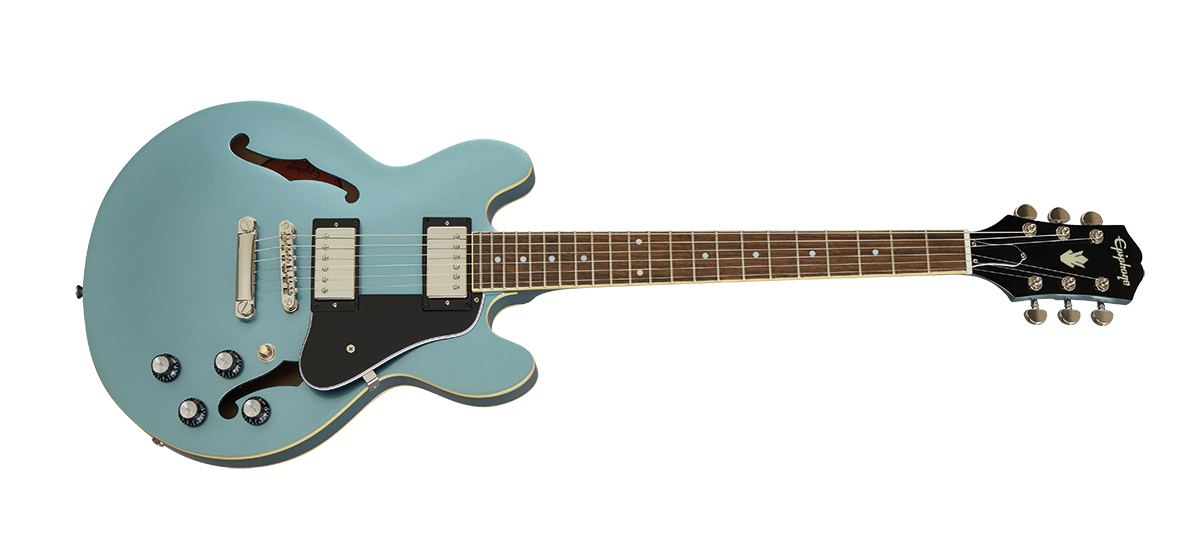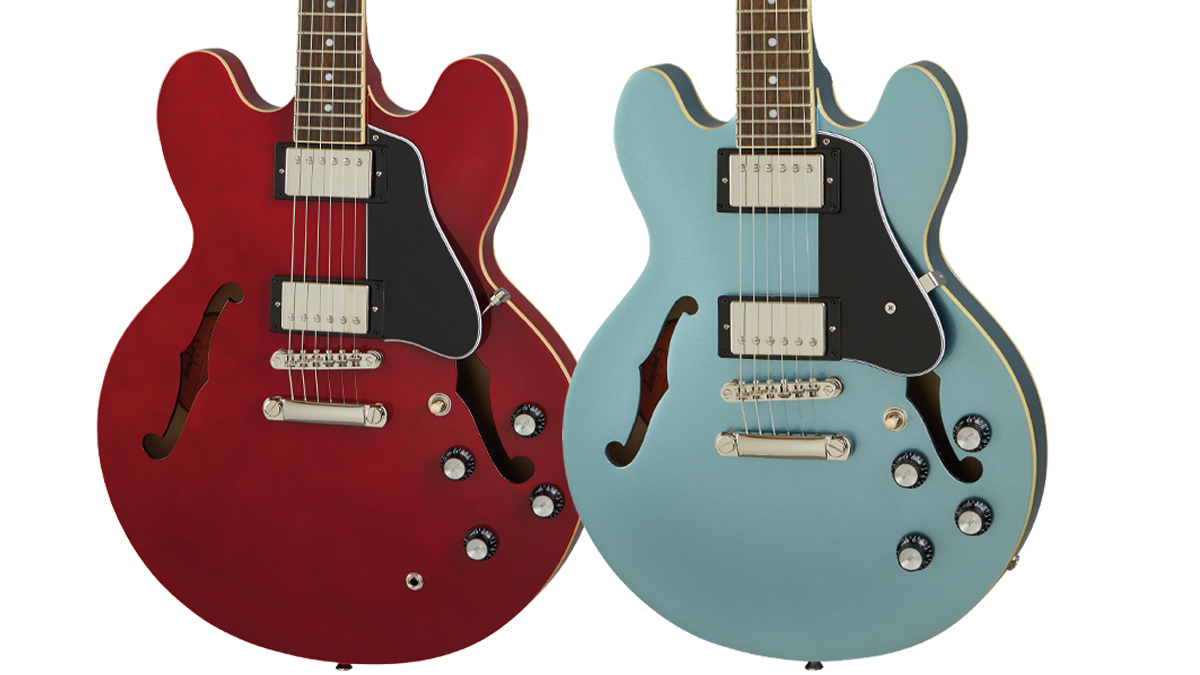Guitar World Verdict
Epiphone’s new ES-335 and ES-339 models allow guitarists to enjoy the original ES semi-hollowbody experience at an affordable price that doesn’t sacrifice tone or playability.
Pros
- +
Superb, versatile instruments.
- +
Big, fat tones and great sustain.
- +
Quality build.
- +
ES-mojo at an affordable price.
Cons
- -
Limited finish options.
You can trust Guitar World
A lot of great guitars were conceived during Ted McCarty’s reign as president of Gibson from 1950 through 1966, including the Les Paul, Explorer, Flying V, Moderne, SG and Firebird. These solidbody models have withstood the test of time admirably, but in my opinion the greatest and most innovative achievement to come from Gibson’s McCarty era was the semi-hollow thinline ES-335.
By combining the best attributes of solidbody and hollowbody designs, the ES-335 and its offspring (the ES-345, 355 and more recent 339) is somehow more than the sum of its parts. A perfect guitar for almost any style of music, the semi-hollow Gibson ES has been a favorite of a diverse crew that includes Chuck Berry, B.B. and Freddie King, Eric Clapton, Eddie Van Halen (in his early days), Ritchie Blackmore (ditto), Alex Lifeson, Johnny Marr and, more recently, Dave Grohl, whose Trini Lopez model is a direct offshoot of an ES-335.
I highly recommend an ES-335 or one of its descendants for guitarists seeking a first instrument as well as anyone looking to expand their collection. In the past, this used to be a somewhat expensive proposition, but, thanks to Epiphone, the price of a genuine ES semi-hollow electric is more affordable than ever. We took a look at two examples from Epiphone’s “Inspired by Gibson Original ES Collection”: the Epiphone ES-335 and smaller proportioned ES-339.

Features
At a quick glance, the Epiphone ES-335 and ES-339 look almost identical, with the latter having a body that’s two inches smaller (the ES-335 measures 16 inches across the lower bout while the ES-339 measures 14 inches) but still maintains the same proportions and curves. However, there are a few subtle differences, with the ES-335 conforming more to original vintage specs while the ES-339 has a few modernized customizations.
Both models feature a body constructed from laminated maple with an arched top and back, both surrounded by single-ply cream binding. The center block, which extends the full length of both bodies, is maple as well. The glued-in set necks are identical, constructed of mahogany with a single-ply cream bound Indian laurel fingerboard and providing a 24.72-inch scale length, rounded C profile, 12-inch radius, 22 medium jumbo frets, dot inlays and a Graph Tech NuBone nut measuring 1.69 inches.
Hardware similarities on both models include a LockTone Tune-O-Matic bridge with LockTone stop bar, floating black five-ply pickguard and black “top hat” control knobs with metal inserts. Pickups are a pair of Alnico Classic Pro humbuckers with nickel-plated covers, and controls consist of individual volume and tone controls for each pickup featuring CTS potentiometers and a three-way pickup selector toggle switch.
In addition to the smaller size body of the ES-339, differences between the two models include vintage Kluson-style Epiphone Deluxe tuners with tulip-shaped buttons on the ES-335 while the ES-339 has Grover Rotomatics with nickel-plated buttons; a top-mounted output jack on the ES-335 while the ES-339’s jack is side mounted; and an adjustable pickguard mounting bracket on the ES-335 while the ES-339 features a less-obtrusive L-shaped bracket. Also, the ES-335 is only available with a Cherry or Vintage Sunburst finish, while the ES-339 provides both of those plus Pelham Blue or Natural options.

Performance
The Epiphone ES-335 and ES-339 sound close enough to each other to fool most listeners in a blindfold test, but the smaller 339 has a little less acoustic resonance and a tighter, more focused midrange than the 335. Both models deliver bold, fat tones with a satisfying percussive attack that morphs into smooth sustain.
The classic-voiced pickups are just slightly hotter than vintage spec, able to push an amp into dazzling overdrive and also clean up nicely when the volume control is backed down even when the amp is dialed to a high gain setting. The tone of both models is perfect for any style of music: classic rock, jazz, blues, alternative and all but the most extreme versions of metal and the twangiest country.
Even more impressive is the attention to detail evident in the construction and playability. In a blindfold touch test, most players wouldn’t be able to tell the difference between these highly affordable models and their much more expensive new Gibson counterparts. With the Epiphone ES-335 selling for $549 and the ES-339 going for only $499, either (or both) are very affordable options for beginners as well as seasoned players looking to expand their sonic arsenals.
Specs
- PRICE: $549/£499 for ES-335, $499/£419 for ES-339
- TYPE: Semi-hollow electric guitar
- BODY: Layered maple with solid maple center block, with one-ply binding; ES-339 measures 14" across lower bout, ES-335 measures 16"
- NECK: Mahogany, rounded C profile glued-in
- SCALE: 24.75"
- NUT: Graph Tech NuBone
- FINGERBOARD: Indian laurel
- FRETS: 22, medium jumbo
- PICKUPS: 2x Epiphone Alnico Classic PRO humbuckers
- CONTROLS: 2x volume, 2x tone, three-way pickup selector
- HARDWARE: LockTone Tune-O-Matic with Stop Bar, Epiphone Deluxe tuners
- FINISH: Vintage Sunburst and Cherry (ES-335), Natural or Pelham Blue (ES-339)
- CONTACT: EPIPHONE
Chris is the co-author of Eruption - Conversations with Eddie Van Halen. He is a 40-year music industry veteran who started at Boardwalk Entertainment (Joan Jett, Night Ranger) and Roland US before becoming a guitar journalist in 1991. He has interviewed more than 600 artists, written more than 1,400 product reviews and contributed to Jeff Beck’s Beck 01: Hot Rods and Rock & Roll and Eric Clapton’s Six String Stories.
“I use a spark plug to play slide. It's a trick Lowell George showed me. It gets incredible sustain – metal on metal”: In the face of sexist skepticism, Fanny's June Millington carved a unique six-string path, and inspired countless players in the process
“An esoteric boutique vibe, superb ergonomics and a powerful, unique preamp – Tobias is back”: Tobias Growler IV review
The heaviest acoustic guitar ever made? Two budding builders craft an acoustic entirely from concrete because they “thought the idea was really funny”












